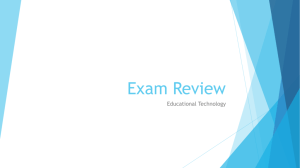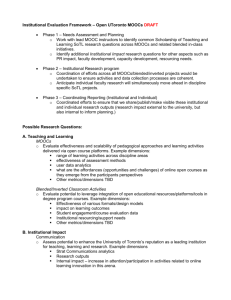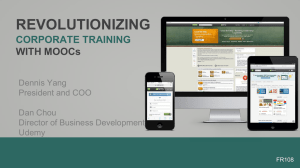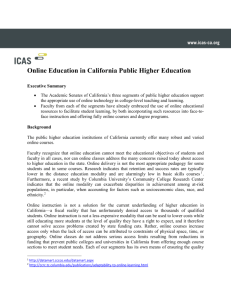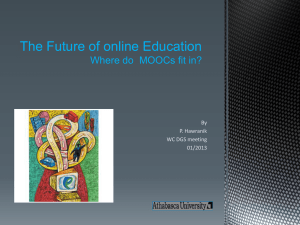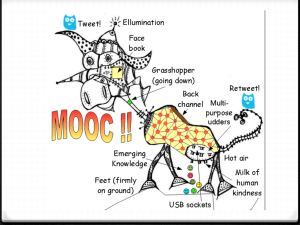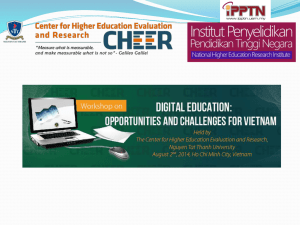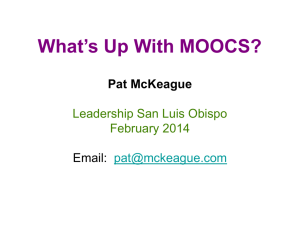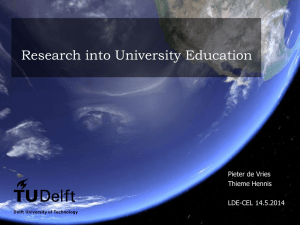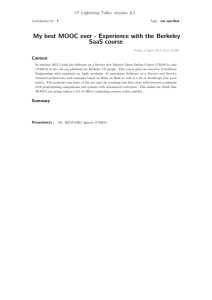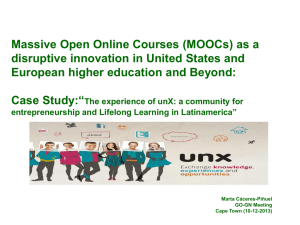Slide 1
advertisement
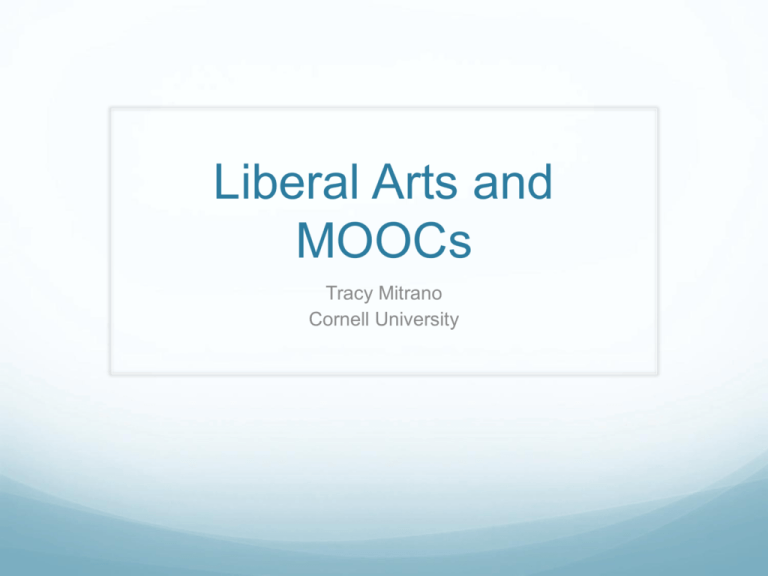
Liberal Arts and MOOCs Tracy Mitrano Cornell University Question? Are MOOCs the end of traditional not-for-profit(NFP) higher education or the beginning of its renaissance? What can the liberal arts contribute to MOOCs? MOOC Massive (very large numbers of people, e.g. the first had over 150,000) Open (free to the user, anyone with an Internet connection can participate) On-line (Internet, including mobile) Course (open to interpretation, for example “semester” or only a few weeks, but typical in the sense of covering defined content) Distance Education MOOCs might be thought of as a subset of distance education Distance education is at least as old as correspondence courses via USPS Military use throughout much of the 20th century Closed-Circuit television enhanced technology Internet Distance Education Both for-profit (FP) and NFP sector have sprung up riding the tide of the Internet Early large-scale experiments such as Fathom in the NFP “elite” schools sectors spent many millions but did not find their worth Some smaller-scale operations still in existence, such as eCornell Professional education (MBA) and training “Information Technology will Transform Education!” To date, that idea has not been realized Rather, higher education has absorbed technology into its structure, hierarchy and traditions Including the concepts and strictures of “classes,” “credit hour,” “degrees” (as the critical credential), and even “sage on the stage” delivery with SMART Boards and LMS Example from Copyright TEACH Act of 2001, amendment of copyright, designed to bring distance, on-line, Internet education in sync with section 110, face-to-face exception. Little used, however, because of the complicated, ambiguous terms, such as “session times” and the authentication requirement Most institutions have fallen back on Fair Use Precursors to MOOCs Global Internet and Information Economy Greater speed, storage, reduced size and entry costs to get on the Internet Mobile Technologies Open software movement Earlier examples: MIT OpenCourseWare Carnegie Mellon University Open Learning Initiative Boom! Professor Thrun and a basic Computer Science course Stanford professor, uses a platform to open to anyone who wants to take it Greater than 150,000 students, more than 25,000 complete the course Issues a letter to certify accomplishment Take Off! Udacity Professor Thrun’s FP company Coursera Stanford graduates create FP company, MOOC platform Bandwagon phenomenon, jump start distance ed edX MIT/Harvard, NFP and not “MOOC” per see UC Berkeley, Wellesley, but not Amherst! CornellX, May 2013 Early Reports Lots of hype, uncertainty, experimentation Not a simple approach to teaching, takes lots of preparation and lead time Basic technical requirements: platform, robust network, video, LMS, etc. Opportunities Branding and marketing for institution as well as professors Experiment with distance or blended as well as life-long learning In the heartland of liberal arts, four year degree education Highlight notable areas of research or great professors, strengths of the institution as well as enhance the outreach, public service missions Either get in the game or stay in the game as higher education becomes more global Challenges Assessment and grading Peer grading and lots of teaching assistants Academic Integrity Physical test centers “Signature Track” with keystroke authentication Credit Hour, Credentials, Badges, Accreditation Range of opinion about ultimate affects on higher education Harvard Faculty Letter of Protest UC San Jose faculty protest How do MOOCs fit into global higher education landscape? MOOCs reinforce the trends of an international, information economy Component of the challenge of NFP HE, insofar as it challenges price, credit hour and traditional credentials Thomas Friedman: Best of education garnered via mobile devices to eager learners around the world But without attention to the challenge of how to fund, accredit and credential Global University Collaborative Courses, classrooms, instructors, communication with researchers around the world Deploy technology to teach differently: Flipped classrooms Professor as a guide, not sage Use MOOCs as “homework” or foundational material, prerequisites for advanced learning The Liberal Arts Perspective Let’s really transform education! Make learning relevant, meaningful and interactive Broaden students’ perspectives on the world in which they live and will have to operate Combine with foreign travel, appreciation and understanding of global cultures Active learning and undergraduate research Combine learning with service through problem-solving Treat education as holistic, and in turn, experience education as treating students, educators – including staff – as whole persons! Digital and Information Competency Berkeley-Cornell Model Goal: Incorporate undergraduate research into course work and objectives Active learning Group process and presentation Digital and information literacy Means: “Clusters” that function as a team Faculty Teaching Assistants Librarians Information Technology Professionals CIS 515: “Culture, Law and Politics of the Internet” Worked with IT staff: Create an alternative to institutional LMS to be open on the Internet for students to write reviews of books, blog, interact with authors and other students from other institutions (Berkman Center at Harvard) Videotape Moot Court Competition Consult and support students in presentation delivery PowerPoint 3D conceptualization Interclass messaging CIS 515: “Culture, Law and Politics of the Internet” Worked with Academic (Law) Librarian: Offered basic legal research instruction Created Moot Court competition using Internet legal issues as the topics Jurisdiction Intellectual property Copyright Trademark Administrative Commercial and Communications Law FTC/FCC Net Neutrality Simulated Product Design Demo Presentation integrating the work of Internet legal scholar Lessig’s “four factors” (law, technology, social norms, market) analysis. Legal research expanded with basic digital literacy skills to do advance search and use of reference librarians generally per specialized data bases and search techniques based on research principles, i.e. evaluation of resources and critical thinking skills Flipped Classroom, real-time messaging, videotaped presentation for post-mortem analysis Evaluation included cluster input about reference research, analysis, presentation mode and lessons learned Peer grading Group/individual analysis Moot Court Used the Official Moot Court room in Cornell Law School Student took the exercise very seriously: Dressed the part Learned the basic procedural protocol for addressing the court (appellate = timed presentations, judges interrupt, three light system to manage time, proper address to judges, etc.) Performed the necessary research, wrote the briefs and delivered oral argument Used all the resources: IT, librarians, TA. Last Day of Class “Put the course site behind authentication! I had a job interview, and the interviewer asked me about my moot court competition case!” How Cool Would It Be … Collaborative work with other professors, in other institutions, internationally? Whether teaching “basic” undergraduate material, for example, foreign language, or essential humanities, i.e. how American history is taught in the U.S. with a professor, class and students in Beijing? Introducing multi-dimensional perspective: history, literature, art, culture, music, economic, social, political and ideological perspectives? From Discipline Approach to Problem-Solving How to work toward environmental sustainability on a comprehensive scale, including prevention of global warming and of the extinction of many species How to create international jurisdiction and substantive law in order to settle legal disputes How to shape a developmental model of a global economy that distributes resources—including education—equitably and fairly around the world Examples: How to inculcate an understanding of local or national culture, history, and traditions sufficiently to encourage tolerance of each others religions, manners, and mores? How to deploy all layers (physical, logical, and applications) of the Internet while also developing international governing bodies and policy principles for information and communications technologies, including search engines and the repositories of information and knowledge? How to optimize agricultural research on a global scale in order to eliminate starvation and hunger? Examples: How to research, manage, and treat disease—and thus provide reasonable health care, including pharmaceuticals— around the world? How to understand the human condition through the study of cross-cultural and trans historical art, literature, languages, and humanities? How to integrate archeology, history, literature, language, geography, sociology and science? Examples: How to live the ethics of scientific research, whether it be the exploration of outer space (and its expenses, given other needs), particle and nuclear physics (and the creation of such devastatingly destructive technologies), Internet and data networking technologies (the use of highly flawed proprietary operating systems without consequence to the companies making profit, notwithstanding the consequences that result to users from those flaws), or genomics and the creation of species for which we do not yet know all of the intended, or unintended, consequences? Will this approach change undergraduate education? I hope so! Do These Changes Signal the End of Liberal Arts? No! These changes should reinvigorate and enrich the meaning of liberal arts education, making it consistent with the demands of international markets and societies, give pedagogical meaning to how technology has the potential to transform education, make education relevant and inculcate global citizenship.
